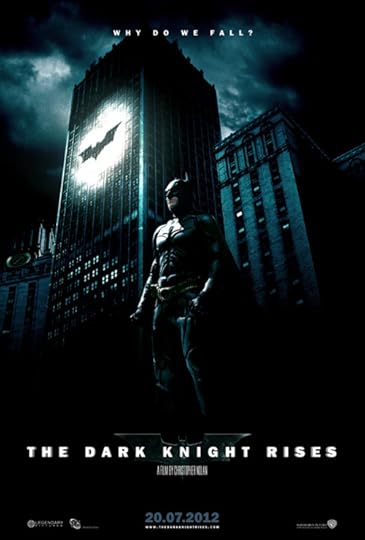Rob Wickings's Blog, page 74
July 21, 2012
All Rise: X&HT Saw The Dark Knight Rises
Right-wing radio host and all-round screw top Rush Limbaugh thinks that the new Batman film has an explicit anti-Republican message. His reasoning? The villain of the piece is called Bane, and Presidential nominee Mitt Romney made his fortune through a company called Bain Capital. It's just all so clear and simple.
We shouldn't laugh too loudly at Limbaugh, easy as it might be. In some ways he's on the money. The Dark Knight Rises has plenty to say about power, corruption and lies. But as with all of Christopher Nolan's films, things are never as straight-forward as they appear.
The spoilers after this point are numerous and mighty. Be warned.
Curtain up. It's eight years after the Bat took the fall for the death of Harvey Dent, and for the two conspirators at the heart of the scam, things don't look good. The Dent Act, draconian measures put in place by Jim Gordon, has chopped crime off at the knees in Gotham. But the Commissioner of Police is torn apart by guilt. The peace he has won for his city has been born from a lie.
Meanwhile, Bruce Wayne is physically and spiritually crippled. Unable to move on, limping around stately Wayne Manor like a ghost. He has been broken by the knowledge that his city no longer needs the Batman. He is a relic of a darker time, described by the mayor merely as a costumed thug. A bad memory.
And yet, he is needed – by the other side. The terrorist known simply as Bane has plans for Wayne's toys, and an agenda that will finish the work his master, the shadowy Ras Al Ghul, envisaged for Gotham.
Bane is the anti-Batman. Dedicated, brutally intelligent, a creature with no room for mercy. This is not the wordless sidekick we first saw in the execrable Batman And Robin. Bane is in every way a match for the Bat, and he understands that Gotham and its masked vigilante are inextricably tied together. First you break the Bat, then you break Gotham.
And break it he does. Isolating the city from the rest of the world, he starts up a revolution, imprisoning the forces of law and order underground, reclaiming Gotham on behalf of the 99%. This is the point where Limbaugh and his ilk should sit up and take notice. Gotham becomes as bad as revolutionary Paris, with a kangaroo court ruled over, deliciously, by an old and familiar face. The two choices he offers the guilty–death or exile–are the same thing. For Bruce Wayne, that realisation is the trigger that brings him back to life, healed and ready to save his city one last time.
The Dark Knight Rises was always going to be an endgame. Both Christopher Nolan and Christian Bale have stated that they have no interest in going beyond the trilogy. It's an epic climax, pulling in threads and hints from the two previous episodes while remaining massively entertaining in its own right. Everyone is playing at the top of their game. Anne Hathaway is a smart, sassy revelation as Selina Kyle, the woman who has always known how to make the Bat work for the win. Nolan's preferred crew of supporting actors, from Michael Caine to Joseph Gordon-Levitt (you'll spend the last minute of the film grinning at the final reveal of the secret that he's tucked away) bring a warmth and depth to their roles that only makes it easier for the audience to buy into the inherent wackiness on offer.
It's filled with jaw-dropping moments, from the tremendous set-pieces to the shocking revelation as to who has been pulling the strings all along. There's plenty here to keep you thinking and talking long after the credits roll. Bane's revolution is a massive lie, a hard-edged satire on the fears of the 1%, and how they view any negative change in their circumstance as a criminal act. It takes a billionaire at the head of a violent army of police to restore order. Should we, knowing what we know about the power structure in Gotham, be cheering quite so hard as the status quo is slotted back into place? Does Bane perhaps have a point?
You'll rarely see a film that handles this level of complexity and nested themes with such care and grace, while at the same time delivering thrills, laughs and shocks by the barrow load. It's funny, sharp and gorgeous. It's not afraid to keep you guessing, and make you think. A packed and cheering Phoenix Picturehouse in Oxford bore witness to a film that I'm already tagging as one of my top five of the year. In a strong field for superhero movies, this is the one that everyone will remember.
It's been a long time since I applauded a film as the end credits rolled. I wasn't alone this time. TDKR took all our hopes and expectations, and rose effortlessly above them.
 Posted with Blogsy
Posted with Blogsy

July 20, 2012
The Dog And Pony Show, or Three Things You Can Do To Help Out Untruths
The one thing I’ve noticed about the wacky world of self-publishing is the sense of engagement that rapidly develops between author and audience. This has to happen. The writer can’t afford to be aloof from his or her readership. The buffer zone that an agent and publisher puts in place just isn’t there.
That’s part of the fun of the self-pub game, but it does mean that word-slingers like me have to extricate ourselves from our cocoon and get out and engage with people. As we tend to skew introvert, that’s kind of tricky, and if you’re a shy retiring flower like me, it’s difficult not to feel like some kind of huckster or hawker when all you’re trying to do is make people aware of the worth and value of your work.
With that in mind, let’s get on with the sales pitch.

The first, biggest, most important thing you can do for Untruths is to buy and read the book. Sounds weird to say it, but sometimes simply saying BUY THIS, IT’S GRATE will do the trick. It’s available at Amazon for 99p. If you haven’t got, don’t want or have no need for a Kindle, then you can get it on Smashwords, which will allow you to download in any format you want, including good old HTML and plaintext. In short, if you have a computer, you can download and read Untruths in less than a minute.
If you don’t want to read the book electronically, then rest assured. I’m working hard on a print version* and, if there’s demand, an audiobook. I’m open to suggestions. Would anyone read a graphic novel version? Claymation? Interpretive dance?
If you’ve read and liked the book, then it’s massively helpful if you tell the world. Word of mouth is the best advertising vector there is. It would great if you could spend a couple of minutes giving Untruths a star rating and, if you have the patience, a review on Amazon. After price, drive-by browsers will check the star rating, and a healthy four stars or over is a good sign of kwalitee.
If again, you’re Amazon-averse, but you want to show Untruths some love, then there are options. Smashwords has a review section baked into the book page. And can I point you at the bookworm’s social network site Goodreads? If you’re bibliophilic it’s a great place to hang, make new friends and connect with Facebook and Twitter buddies, and even authors. I’m on there, of course.
Speaking of Facebook, Untruths has a Fan Page which is looking a little unloved at the moment. Although X&HT will always be the primary newshose for Untruths chat and blather, the BookFace page will also have exclusive content, which currently includes the first pic of a fan happily clutching his copy of Untruths.
So there you go. That’s four ways you can help out Untruths, not three. Dammit, I’m a writer, not a mathematician.
*Speaking of which. My first foray into self-published fiction, The Dead Files Vol. 1, is now available as a paperback. Buy one and wave it in front of me and I’ll happily sign the thing. Same goes for Untruths when I pull my finger out.


July 16, 2012
Stacked: X&HT Visited The Astley Book Farm
Sometimes, you just have to make the most of a collapsed plan. We were all set to visit the Festival of History at Kelmarsh Hall in Northamptonshire this weekend, until the weather did a dirty on us, and flooded the site the evening before it was due to open.
We found a silver lining to that rain-sodden cloud, tucked away in the lanes of rural Warwickshire. A bookshop that swallowed us whole and ejected us hours later, giddy and shine-eyed.
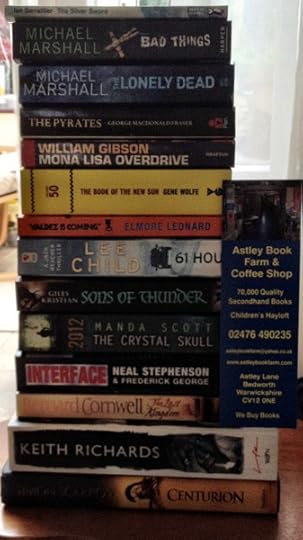
The Astley Book Farm, near Bedworth in Warwickshire, is one of those places that makes book junkies like TLC and I slaver with glee. A vastly rambling labyrinth of a place, it runs over several converted barns, and covers everything from exquisite rare items and achingly exclusive collectibles all the way down to what the proprietors call “the ten-bob barn” – battered old paperbacks by the stackful. It’s one of those places where you can drop a big wedge of cash on the book of your dreams, or a surprisingly small amount on a couple of carrier bags full of swag. That was the approach we took, grabbing a armful apiece of thrillers, classic SF and fantasy and historic. The pic to right shows off our stack in all its magnificence.
The Book Farm is not a place that rewards the abstemious or frugal approach. It’s stuffed full of books, and they all want to come home with you. The average volume goes for a couple of quid. We both went back to the cash desk a couple of times, stumbling across must-haves after declaring the quest to be over. TLC found one of her childhood favourites, Ian Seraillier’s The Silver Sword, that had come in that morning and hadn’t even been priced. It had to be done.
Bookshops like The Book Farm are a brilliant antidote to places like Waterstone’s. Eccentric, wonky and filled with a low, warm glow of love for the power of words. They have an on-site book-binder that will repair and restore any treasures that need fixing. There’s even a cafe with great coffee and snacks (we recommend the Warwickshire sausage roll, a great chunk of porky deliciousness that puts your Ginster’s nonsense to shame) and wifi. You could, I suppose, if you were a complete churl, hook into Amazon and pick up a title or two on your Kindle if they didn’t have the title you really wanted in stock. But that would be deeply low-class. And the staff pride themselves on being able to grab anything your little heart could desire.
The Book Farm is a remarkable, dizzying maze of literary goodness. If you’re bibliophilic, then I guarantee that you’ll find it impossible to walk out with anything less than an armful.
Go get some.
The Astley Book Farm is off Astley Lane, near Bedworth in Warwickshire. More here.


July 15, 2012
Code Of Silence
Westminster Council have a reputation for sucking the fun out of any party. The pubs in Soho are well known for the draconian restrictions placed on them in terms of drinking outside, and the fenced-off demarkation zones have to be strictly enforced on pain of a heavy fine.
But now they’ve gone to far. Although the blame has yet to be categorically laid at their door, Westminster Council are at least indirectly responsible for cutting off Bruce Springsteen.

The Boss was playing in Hyde Park last night as part of Hard Rock Calling – a weekend of gigs that this year include names like Paul Simon and Soundgarden. As ever, he gave his all, delivering a dynamic three-hour set, culminating in a couple of Beatles songs featuring none other than Paul McCartney. It was a gig destined to go down in history as one of the most memorable of the 21st century.
Which is exactly what happened, for all the wrong reasons. At 10:40, after a barnstorming blast through Twist And Shout, the speakers went dead. A technical fault? A power outage caused by the miserable weather? Nope. Westminster Council had imposed a 10:30 curfew on the event and, in an act of jaw-dropping hubris, an unidentified jobsworth cut the power. McCartney stalked off stage and Bruce, after an abortive attempt to kick off one last song, was forced to mutely shrug to his audience and leave.
Accusations are flying, with Westminster Council defending their curfew but pointing out that it was the concert organisers Live Nation that cut the power. After all, every minute that an artist goes over the scheduled finish time triggers an increasingly hefty fine. This was an argument that didn’t fly with Springsteen guitarist Steve Van Zandt, who took to Twitter to simply point out:
Hard Rock would have let us play all night.—
Steven Van Zandt (@StevieVanZandt) July 15, 2012
Even Bozo Boris the Comedy Mayor has entered the fray, saying on LBC Radio:
“If they’d have called me, my answer would have been for them to jam in the name of the Lord.”
Van Zandt’s loyalty to Live Nation aside, it looks like this isn’t the first time Hard Rock Calling has stomped on The Boss, whose epic sets are notorious for over-running. Twitterbuddy and fellow Bossaholic Simon Aitken recalls the last time Bruce played Hard Rock:
@Conojito Westminster strike again. When Springsteen played Hard Rock Calling last time, they wouldn't let him play an encore…—
Simon Aitken (@Simon_Aitken) July 15, 2012
@Conojito we missed out Springsteen doing a duet with Jon Bon Jovi!—
Simon Aitken (@Simon_Aitken) July 15, 2012
…which sounds like the sort of buzzkill for which Westminster Council have a great deal of form. The end result is that a gig that should have gone down as one of the all-time greats will be remembered for very different reasons. I hope the joyless pen-pusher who authorised cutting the mikes, and the spineless jobsworth who actually did the deed, are very proud of themselves today.
I doubt that we’ll see Bruce in Hyde Park again anytime soon. The last time I saw the Boss, at the Emirates, he put on an amazing show that merrily over-ran by half an hour. Somehow, we all survived and got home without any problems. Shame Westminster Council can’t see how that could possibly work.








July 7, 2012
A Swinging Time: X&HT saw The Amazing Spider-Man
Comics are soap opera. Characters don’t change. If they die, it’s hardly ever permanent. Their origins are constantly retold, reinforced, raked over for any new tiny scrap of resonance. Some critics have griped that The Amazing Spider-man, the fourth movie about Peter Parker and his penchant for going out in red Underoos, is a rehash of Sam Raimi’s 2002 film.
They’re missing the point. This kind of thing happens in the funny papers all the time.
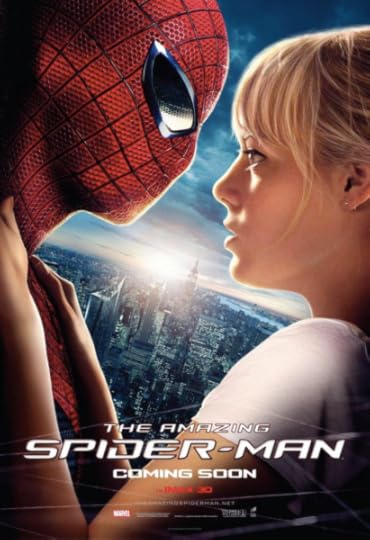
Truth be told, I walked into an early afternoon screening of Amazing Spider-man with low expectations. I wondered what a new director like Mark Webb, best known up to now for the quirky rom-com (500) Days Of Summer, could possibly bring to the table. Turns out he was not only the right man for the job–he’s reinvigorated a franchise that had sunk into overblown mediocrity.
By harnessing his skill with unconventional romance, Webb has made a film with a lot more to offer than simple crash bang wallop. He pins the film much more closely to the burgeoning love story between the loveable geek Parker and his girl, the luminous, fearsomely intelligent Gwen Stacey. Casting is key to making this work, and he has nailed it throughout. Andrew Garfield is far less of a punching bag than we’ve seen before, bullied but by no means a bottom feeder. The object of his affection, Gwen Stacey, is no girly-girl. She’s the equal if not better of Petey when it comes to science, and Emma Stone plays her perfectly. You can see why Pete falls for her so hard. I did too. Emma has crafted a character with real charm and magnetism. Sure, she’s a looker. But she’s so much more.
The rest of the casting is equally spot on. Martin Sheen’s Ben Parker has the gravitas and sturdy wisdom you’d expect from an ex-President, and I’m fully behind the idea of making Aunt May less of a doddery old prune and more, well, Sally Field. Rhys Ifans brings a tragic Shakesperean weight to his take-over of Curt Conners. I could never see Dylan Baker as The Lizard. Ifans has the monster in him from the very start.
Sure, things are missing. No JJJ, hardly any Daily Bugle. But by putting Peter back in high school, there’s no real need. He’s a sophomore, not a struggling shutterbug. Besides which, no-one else could play Jameson like JK Simmons. It would be foolish to try. If nothing else, it would bring the comparisons between Webb’s film and the Raimi trilogy roaring back.
There are nods to the earlier film, though, with a couple of shots in a wrestling ring that again tie the superhero and luchadore genres closely together. And although it’s never said out loud, the words “power” and “responsibility” do pop up in close proximity to each other. I’m not convinced of the wisdom of these cheeky references to the Raimi years. Better to make a clean break with everything that’s gone before, go back to the richness of the source material, and craft a completely fresh take.
Speaking of responsibilty, it was nice to see a big fat credit for Steve Ditko front and centre in the credits. Columbia have clearly learned from the debacle of barely mentioning Jack Kirby in The Avengers end roller. The acknowledgement of the fifty years of history in the Spiderman character is important and it was nice to see the co-creator of all those stories get his due.
I actually prefer Amazing Spider-Man to the earlier version of the origin story. Raimi’s broad comedy stylings have been replaced with something a bit more subtle, a little more sharply-observed, a little deeper. Granted, there are no iconic moments like the upside-down kiss, but ASM is by no means a pedestrian retelling of the tale. By poking at one of the great unanswered questions in the Spidey story–whatever happened to Pete’s parents?–we have the underpinnings of something that could take the character in genuinely new and interesting directions.
Spiderman 3 put a lot of people off the idea of the friendly neighbourhood web-slinger on the big screen. I hope that Marc Webb’s new take on the story can reinvigorate that interest. There’s a lot of stories left to tell and, if the path is followed that I suspect, some truly tragic events in store for Gwen and Peter. In a lot of ways I hope I’m wrong, because I truly bought into the two as a couple.
I think this one’s got legs, Readership.








July 4, 2012
Sheets For Screens: A Night At The BraineHownd Awards
Mark Brown paces around outside the Hideaway Bar. The brim of his trademark fedora is low, but the shadow it casts can’t disguise the worried look on his face. His go-to guy has bailed on him at short notice. Which means that, if the emergency back up plan doesn’t pan out, he’s going to have to find a way of running his popular film night without a projector.
He glances back at the rapidly filling bar behind him. He’s had better days.
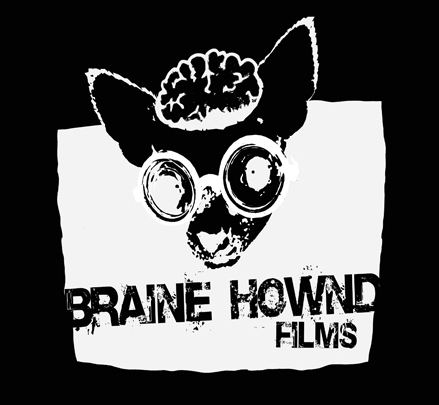
Short film nights are popping up all over the capital these days, taking advantage of cheap digital technology to give no-budget movie-makers a chance to meet and show off their masterpieces over a beer or three. Sure, you can put your movie up on YouTube and Vimeo, but then it’s just there, in isolation, at the mercy of the haters. Nights like the monthly BraineHownd bash that Mark runs with his film-making partners in Tufnell Park, North London help to bring a sense of inclusiveness and community to the scene.
At their best, short film nights are raucous affairs, a cross between a stand-up show and an open mic night. BraineHownd have been hosting nights at the Hideaway for over a year, and they know what works. It’s far and away the most prestigious film night on Junction Rd. The Hideaway has a good downstairs room with a bar, and a decent kitchen doling out great thin crust pizza. You can get your food on and beer on, pay a tiny entry fee and know that you’ll be well entertained.
I was at the Hideaway to support my friends. Every six months, BraineHownd host an awards evening where they celebrate the best films they’ve shown in several categories. Simon Aitken was nominated along with writer and actor Ben Green for Sans Sous-Titres, and Leading Man Clive had a Best Music nod for Gunplay, the first film he and I worked on together. There were a lot of good films in contention, and the excitement was thick in the air. We cackled in a corner, plotting Blood And Roses: The Musical (best tune: Spill The Claret, to the tune of Elmer Fudd singing Kill The Wabbit) while waiting for the projector to show.
It did, finally, to Mark’s palpable relief, and we took our seats in the Hideaway’s cosy downstairs bar half an hour late. The crowd, having the chance to fit another beer in, were cheerfully rowdy.
Fortunately, the MC for the night was up to the job of keeping things under control. David Whitney, actor and stand-up, has a built-in PA system, and his booming voice can effortlessly fill a room. As a veteran of some of the most brutal comedy nights in town, he will not suffer fools gladly, but he will gladly make fools suffer.
The first award of the night, for Best Music, went to Eventide, an honest, lyrical cinematic eulogy from a son to his father. It was heartfelt and warm, sad and celebratory. A fine start.
Next up, cinematography, which went to a taut little office-set thriller called First Date. I’ve worked with the cameraman, Matthias Nyberg before, and his punchy lenswork made the most of this twisty urban thriller. It has a lot in common with Out Of Hours, which made Clive worry that the market was over-stuffed with films set in an office on a Sunday. I think he’s made the better film, and I made sure he knew that.
After a short break (an extra beer means an extra trip to the loo), the Best Screenplay award went to Ben and Simon for Sans Sous-Titres. They bickered over this – Ben wrote the script, but the award went to both. It’s a minor grumble, to my mind. They have every right to be proud, and Sans Sous-Titres is a great, sour-sharp shot of black humour.
Best Actor went to Chris Spyrides for International Wife Shouting, a Pythonesque short-short that pinned the frustrations of modern manhood into two minutes. Where, indeed, is the remote? Chris does a great line in eye-bulging rage, and I roared throughout. He, sweetly, refused to believe that he’d won and demanded a recount. Sorry, Chris, this one was well deserved.

Things started to get a little surreal from then on in. The Best Director award went to Alex Horsfall for Looking After Edward. She didn’t show, and neither did the DVD. So they showed The Angry Man instead, featuring another vein-popping performance from Best Actor nominee Daniel Dresner. A portrait of the trials and everyday nightmares of the jobbing actor, it was sharply observed and utterly hilarious.

Finally, the big one: Best Film. Act Of Vengeance won the prize. But no-one from the production bothered to turn up. In a delightful, jokey fit of pique, Mark decided not to show it, and screened the runner-up, The Romantic Killer, instead. This lush, gothic thriller packed a ton of tension and genuine heart into its fifteen minute running time, and it was a worthy climax to the evening.

As we stumbled back up into the clear, cool air of a North London night, I took the time to congratulate Mark on a well-played event. It was ramshackle, surreal and hilarious, and I’d had a real blast. I think nights like BraineHownd, or James Rumsey’s Feast On Film in Crouch End are well worth seeking out if you want to know what lo-to-no budget film-making looks like here in the second decade of the 21st century. They may be pinning up a sheet to use as a screen, but the ingenious use of cutting-edge tech to tell stories with real warmth and heart shows that the future of British film is not in Bafta or the BFI, but in underground events run by committed, talented people in back rooms and basements across the country.








July 2, 2012
How I Wrote A Book
Ok, relax. This is not going to be one of those posts where I talk about the inspiration, background and hilarious stories behind the tales on my new ebook, Untruths, in exhausting detail. That would be dreadful.
Instead, I wanted to answer the question quite a few people have already asked: how difficult is it to get an ebook published?
The answer is, of course–it depends.
Let me clarify. Writing is a tough gig, filled with uncertainty, loneliness, paranoia and occasional bouts of planet-wrecking egomania. The process of getting a story out of one’s head and onto the page or laptop or scroll of vellum is painful, tedious, astonishing and addictive. I can’t tell you how to write a book. I can’t even really, despite the title at the top of the page, tell you how I wrote my book. It kinda sorta just happened.
But the joy of being a writer in the 21st century is that when you finally have your masterpiece, it’s un-nervingly easy to actually get it into a place where people can read it and, gods forbid, actually drop you some coppers for it. And that’s what I wanted to talk about in this post. The process that led up to the moment where I pressed the big yellow button marked SAVE AND PUBLISH.
Let’s start with an admission. I don’t use Microsoft Word. The bloody thing gives me palpitations. In an office environment it’s fine, I guess, if you need to generate reports or spreadsheets or presentations or newsletters. It’s great, once you get your head round the dizzying array of options, for putting together long, complex documents. It should be perfect for novels then, right?
No. Wrongo. It’s horrible for fiction. There’s no easy way to bolt together all the research, notes, weblinks, pics and folderol that goes into the standard novel. A work of fiction does not spring from the wide brow of the author fully-formed on wings of shining prose. It’s wrestled out, bit by bit, ugly draft by ugly draft, hammering ideas into shape and hammering them some more until they go in the hole you knocked in the drywall for them. A novel is like the scenery for a film. It looks amazing from a distance, but go round the back and you’ll see the struts and jerry-rigging that just barely hold the teetering edifice upright. Writing a book is a messy business, and sadly I’ve never been able to get Word to play nice and do what I need it to do.
When it comes to generating an ebook, Word is even worse. Here’s the point where I have to get technical. Sorry and all that.
An ebook is, at heart, a styled HTML document–the same language you use to write websites. If you have the skills to bang out something for the web from raw materials, then coding an ebook should hold no mysteries. Sadly, we writers are a technically unsavvy bunch. We think HTML is a short way of saying Hotmail. So when we fire up Microsoft Word and see that it can export ebook files, well, that’s great, isn’t it? Hit one button, publish to Amazon, next thing you know they’re calling you the new Stephen King. Simples, meerkat chirp.
This is what you get for being a fantasist. Word can do the job, as long as you realise that it tucks an awful lot of stuff in the background that can lead to your perfectly-formatted masterpiece look like the aftermath of that time the dog chewed on your keyboard. When you’re coding an ebook, you need to understand the Styles pane, have all the hidden characters in plain view, and be veeeery careful with your paragraph breaks. Failure to do so leads to heartbreak.
All of which leads up to the answer to the question at the top of the page (look, you can still see it if you squint, way off there in the distance): it’s very easy to get an eBook published–if you use Scrivener.
Settle down, Readership, I’m about to wax lyrical. Scrivener is the best bit of story-writing software out there. It has the capability to effortlessly take in all your scruff and nonsense, the notes that you’ve banged into your phone and tucked away in numerous dusty “ideas” folders for time immemorial, and allow you to organise them in a way that lets you clearly build up a book. It lets you bang out a first draft in short order when you’re ready, reorganise chapters and scenes with a click, shift stuff around in a view that deliberately impersonates the classic index card and corkboard setup. Your character notes and research are all in the project with you, accessible in a second.
It takes a little getting used to, because it’s such a radically different way of thinking. Scrivener will not let you see a finished document until you compile all your materials at the end of the job. Then you can export in any format that makes sense, from Epub and Mobi to RTF and even, if you feel the urge, Word. That allows you to tweak a little more if you need to (a bit more on that in a sec) before sending your magnum opus off to Amazon or your editor. There are modules for film and TV screenwriting, comics, scientific reports, poetry, and a blank one for when you feel the need to get your Scrivener-fu on and build a project your way. It’s endlessly customisable and forgiving of your faults and fubars. Sadly, it won’t make the coffee, but apart from that it’s the best friend I’ve got when it comes to knuckling down and banging out the word count. I know we writers are a stubborn, superstitious bunch, and once we find a solution that works, we like to stick with it. But I think you would be missing out if you didn’t give Scrivener a test drive. There’s a 30 day trial, plenty of time to knock out a short story or script. It changed my writing life. It could do the same for you.
Right, gush over. Because I found a weak spot in Scrivener’s export settings. At least, for this project. Here’s Untruths, in Scrivener, ready to be exported.

You can see all the stories in their folders, neatly ordered and good to go. The problem is that Scrivener views these folders as chapters, and will label them as such in the final export. All fine and dandy, except I don’t want my stories to be called chapters. I just want the story title at the beginning. There’s no obvious way of doing this in Scrivener. Which means a bit more jiggery-pokery is needed.
To solve my problem, I have to squirt an ePub out of Scrivener and into Sigil, a free utility for editing that file. In Sigil, I can quickly dig into the ePub, tweak the headings (and while we’re at it, the table of contents; Scrivener helpfully gives each entry a chapter heading too. Which will be great in the future, just not for this project). Once done, it’s just a case of Save As, dump into Calibre, an absurdly well-specced ebook conversion program, and use that to fire out my final Mobi. There’s an easier way of doing this, I’m sure (for example, there’s a Windows-only thing called MobiPocket Creator that’ll let you skip the final conversion step–anyone know if there’s something similar for the Mac?) but for a first crack at it this seems to work. I use Calibre to email a copy of the file to my Kindle for a final check, aaaaand we’re done.
End result: a well-formed file that Amazon accepts without a word of complaint. This is a process that I’m certain I’ll streamline further as I put new stories on, but for now, I’m happy. Let’s put it like this–I have a book, compiled from a stack of different files from different computers and thumb drives, and with a couple of hours work have put it up for sale on one of the principle ebook retailers on the planet. I am enormously pleased with myself.
There’s a fall coming, I know it. Amazon isn’t the be-all and end-all, and I know other outlets are not so forgiving. Smashwords is already wiping the grin off my face. I will prevail. In fact, I already have, to an extent.
Untruths is available to buy through Smashwords.
It’s not on the Premium Catalog that allows the book to be sold through Barnes and Noble, Sony, Kobo and Apple, but that’ll come soon enough. I’ve already learnt so much. And I still have to figure out the print edition.
Who said self-publishing was easy?








June 28, 2012
So I Wrote A Book
A little over thirty-six hours ago, I took a deep breath and clicked the big yellow button on Amazon’s Direct Publishing site. The one marked SAVE AND PUBLISH. Wheels span for a moment in the guts of my Blackbook. Then a congratulatory notice pinged up, and a book that I had spent a day’s work and fifteen years writing was on its way to the Kindle Store.
Big news, Readership. You can buy some of my writing on Amazon.
The book is called Untruths. It’s a compilation of all the short fiction that’s been available on the site since I started Excuses And Half Truths. For the time being, at least, that short fiction will stay as it is. If you want to read it for free, you can continue to read it for free here.
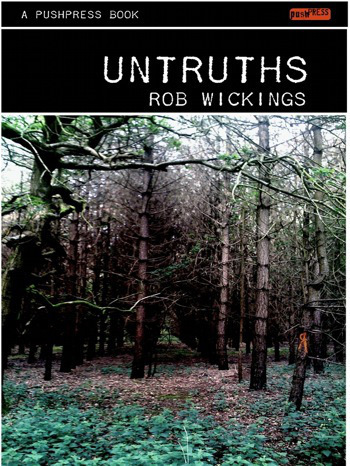
Why should you pay for product I already offer for zero dinero? Well, it would be silly of me to charge without adding value. Every story featured in Untruths has been extensively reproofed and tweaked, and some truly grim smelling pisstakes excised. The stories have been compiled in a way that now shows the connections between some of them. I’ve written new introductions for each tale, giving a bit of background, context and history. And there’s a new story, A Mercy Killing, that gets its premiere in Untruths. A gen-u-wine exclusive. For you, Readership. Because I love you.
Added to that, I’ve designed a cover for the whole shebang, with a unified design aesthetic that will carry across into everything else that I put up for the foreseeable future. If you see anything of Jan Tshichold and Germano Facetti’s work for Penguin in the cover – congrats, you’ve just spotted one of my major influences.
And there’s lots to come. I’m about to start work on a reproofed version of Satan’s Schoolgirls, which will come with cover art from a very exciting new talent. I want to light a fire under the Pirates trilogy, starting with the first appearance of Pirates Of The Moon before year’s end. That’s right. I said trilogy. From there, who knows? There’s a lot of stuff in the tank that I’m just dying to turn the tap on. Perhaps, finally, The Prisoner Of Soho?
For now, there is work to be done around Untruths. A Smashwords version will be ready before the end of the week (as long as I can get my head back around Microsoft Word, *shudder*), and I’m pressing the go button on a print version through Createspace. I’ve already had a request for an audiobook version, which I should have seen coming (hi, Sandi). That’s gonna need some research. And a little help. Anyone?
And of course, The Dead Files continues its lurch towards world domination – the call for submissions for volume 2 is coming very soon indeed. I hope to get a story in there, but we’d love to be swamped by work from new writers, so let me know if you’re interested.
But right now, I’m just basking in the glow that comes from typing my name into Amazon and seeing it come up prefixed by the one word that has honestly been my one ambition since I was a boy scribbling away at tales of starships, monsters and adventure in a Black ‘n’ Red notebook.
Author.
Untruths is available to buy at the Amazon Kindle Store for the low, low price of 99p.








June 24, 2012
Sunday Songs: SEXYMIX
Perhaps I should explain myself a little.
One of the most important discussions to be had about the internet is on privacy. The ever-increasing desire for government and business to know what it is you do online is creepy and greedy in equal measure, and I believe strongly in making sure that I am in control of what information I allow out into the world.
One man’s comfort zone is another man’s straitjacket, however, and if you want to spread yourself all over Facebook then go to it. As long as you’re aware of the risks and the tools available to make sure that you’re in control, then your digital life is yours to lead, and it would be remiss of me to tell you what to do.
That argument goes the other way, of course, and I find my ghast occasionally flabbered by a minor privacy issue that gets blown up out of all proportion, particularly when it comes to the “difficulty” on switching on privacy controls. It’s a simple box-ticking exercise that takes 5 minutes.
Back in February, celebrity doctor and statistician Ben Goldacre and Father Ted writer Graham Linehan got their panties in a pretzel over the fact that Spotify’s sharing controls were defaulted to on. One of the reasons they gave for this being a bad idea was that interested parties could see if you’d put up a playlist of songs you liked to play during sexytime. It was an idea I found laughable then, and still do.
But it got my little brain cells working, and the very next playlist I put together was a discordant mash of death metal, tooth-gritting avant-garde and sleazy old blues numbers. Of course, I called it Sexymix.
Graham, Ben, thanks for the inspiration. This one’s for you.








June 21, 2012
End Of The Century – X&HT Read LOEG: Century 2009
A common complaint levied at Moore and O’Neill’s League Of Extraordinary Gentlemen books, especially in the later stages of the story that are chronicled in the Century stories, is their impenetrable metatextuality.
It’s really easy to tie yourself in knots when you discuss LOEG. I mean, just look at that first sentence. Impenetrable metatextuality? Good grief. Way to lose an audience. Let’s try this again. In English.
L et’s start with what we know. The world of the League is populated by fictional characters. I mean, it’s a work of fiction, so of course it’s filled with made-up people, but in this case that’s doubly true. It’s a world where popular fiction is the entire landscape, where there is a real Bartlett administration in the US, where Sid The Sexist rides a bus driven by Reg from On The Buses. In the LOEG books, spotting and recognising the cultural references becomes almost as important to the full enjoyment of the story as the story itself.
et’s start with what we know. The world of the League is populated by fictional characters. I mean, it’s a work of fiction, so of course it’s filled with made-up people, but in this case that’s doubly true. It’s a world where popular fiction is the entire landscape, where there is a real Bartlett administration in the US, where Sid The Sexist rides a bus driven by Reg from On The Buses. In the LOEG books, spotting and recognising the cultural references becomes almost as important to the full enjoyment of the story as the story itself.
Therein lies the problem for many readers, especially when the crowd scenes (and there are a lot of crowd scenes in LOEG) become stuffed with faces that you feel you ought to recognise, and that might be important. The amount of detail becomes bewildering.
I prefer to think of the references as another layer, because you honestly don’t need them to enjoy the story. I tend to read the LOEG books two or three times in the first couple of days after they drop onto the map. Once straight through for the story, and then again to parse the artwork and script for the playful other touches. It’s a rare book that can be both textually dense and yet so easily re-read.
I found that Century: 2009 was a pleasingly complete final chapter. It tied up a lot of loose ends, reintroduced old characters in new contexts, and generally finished things off in a nicely satisfying way. The main arc, which traces the efforts of Mina Harker, the immortal Orlando and Allan Quartermain as they struggle to prevent the rise of the Anti-Christ, is surprisingly straightforward, although Moore depends quite a bit on the old deus ex machina – quite literally, in this case. But he’s too sophisticated a storyteller not to know what he’s doing. Is there an element of atheism at work here? After all, he puts G_d in a world where every character has been pointed out as explicitly fictional.
Moore has been extremely subtle in populating his meta-fictional world. Copyright issues means that he’s had to be sly in revealing his cast. Let’s put it like this – you might think that it’s Arthur and Terry from Minder beating up a mark in a back alley, but I couldn’t possibly comment. Kev O’Neill’s characters are just off-model enough that you’re constantly doing double-takes. The burgeoning community, led by pop-culture nerdlord Jess Nevins, that takes joy in spotting and cataloging the characters, songs and brandnames of the LOEG world is going to have a field day with this one.
This trick is especially impressive when Moore shows us who his Anti-Christ is – making the villain possibly the most recognisable fictional character of the last ten years is a coup that takes some pretty big cojones to pull off. The moment when the audacity of that reveal clicks on is delicious. It’s a big moment that makes the climax of the story all the more epic.
The Century books aren’t for everyone. They’re arcane, deliberately obtuse and wilfully perverse. Which makes them all the more attractive to an arcane obtuse pervert like myself. If you like your comic and cultural history cut with a strong dose of absurdity and playfulness, then I can heartily recommend them.









